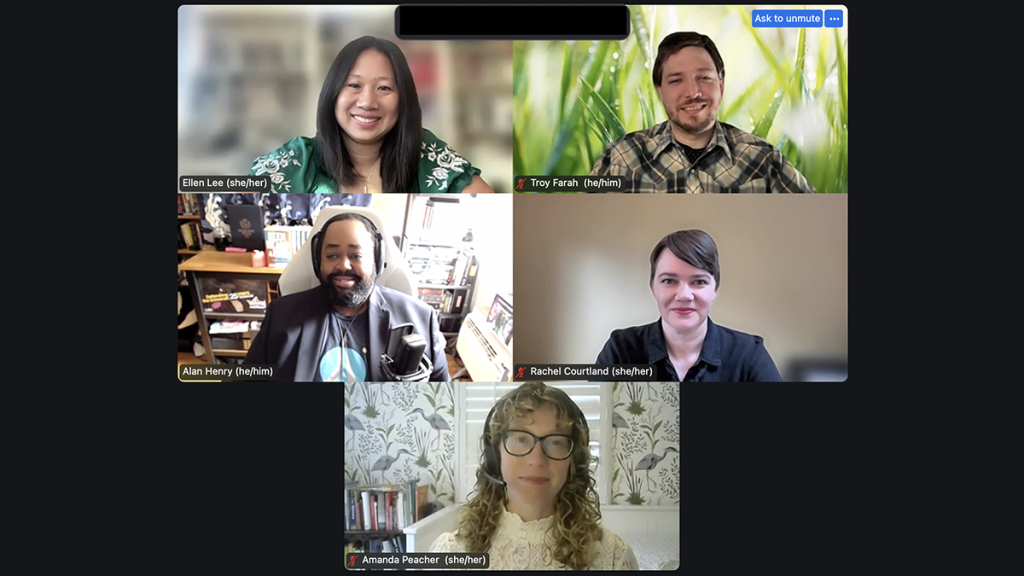
Editors from Marketplace, MIT Technology Review, PC Mag and Salon.com share what they want in freelance pitches in a webinar by the Institute for Independent Journalists. Courtesy of Katherine Lewis
5 reasons your freelance pitches are falling flat
Before complaining that editors ignore your pitch, check yourself
In my 16 years as a full-time independent journalist, I’ve talked to countless frustrated freelancers who complain about their story ideas being ignored or ghosted. I sympathize. Cold pitching is my least favorite part of freelancing.
However, I’ve also talked to hundreds of editors and producers who complain about freelancers pitching ideas that are completely wrong for their news organization. Since starting the RJI innovation fellowship, I’ve had even more conversations with news organization gatekeepers about the inadequate pitches and reporting they encounter, and some downright bad behavior by freelancers. They are eager to connect with solid independent journalists at events hosted by the Institute for Independent Journalists, but they’ve also developed a list of red flags that tell them to ignore a pitch.
In hopes of bridging the gap between freelancers and the assigning editors and producers on the other end of a pitch, I’ve compiled the top five reasons editors ghost freelancers.
1. They are overwhelmed
We’ve lost nearly 8,300 journalism jobs in the past three years, according to Chicago-based outplacement firm Challenger, Gray and Christmas. That’s out of only 89,330 people employed as newspaper, broadcast and online editors, reporters and journalists in 2023, according to the Bureau of Labor Statistics. That means any editor whom you pitch is likely to be handling the workload that one or two additional people had supported a few years ago. Or, they could be new to the job — after having been laid off — and still figuring out a new shop while fielding a steady flow of pitches. Editors who spoke in IIJ events reported getting anywhere from 10 pitches to 100 pitches a week, on top of their other email, so yours may simply be buried in the pile. Another possibility: they could be job hunting. In the past three weeks, I heard from two editors who had been sitting on pitches — and they shared that they’re leaving their news organizations. Suddenly, it made sense that they waited to respond until they could tell me with certainty whether they’d be there to see my story through the editorial process.
Some strategies for cutting through this overwhelm:
- Use a clear email subject line. One winning formula is: “Freelance Pitch” followed by a potential headline that you envision for the story. That helps you stand out from public relations pitches.
- Write as concisely as possible. A pitch needs to answer three things: why this publication should run this story, why now, and why you are the one who should write the piece. Hone in on those three factors and link to supporting materials, clips and other pieces of information that could clutter the email.
- Anticipate and answer any questions or concerns. Editors want to know if you can execute the project you’re pitching. Make it clear if you have access to documents, data or interview subjects. Share examples of past work that shows you have chops.
2. Unrealistic pitches not backed up by experience
That brings us to the second reason you may be pitching into the void: Your skills aren’t there yet. I’ve talked to many student journalists or beginners who are proposing wildly ambitious narrative journalism projects that don’t line up with anything they’ve created in the past. Editors and producers who receive these ideas would be taking a risk to give out an assignment without a track record — and very few news organizations have the spare budget or time to absorb a botched assignment that’s already been scheduled on their editorial calendar.
Instead, be realistic about what kind of projects someone with your experience often produces. Pitch a narrower slice of the coverage you’d like to do, on a scaled-back basis. Or, perhaps, pitch that more ambitious project at the local level, where you won’t be paid as well, but you may find editors willing to take that risk because there’s less money at stake — and less competition in their inboxes.
I also recommend deconstructing the resumes and career paths of professionals you admire, to identify these more realistic targets. You will start to see patterns of the smaller but well-respected publications that paved the way for your mentors to win assignments from the New Yorker, NPR or Vanity Fair. Once you chart the path to success, you can backtrack to see where that first step might be for you.
One of my favorite questions to ask editors whom I would like to pitch is: “What part of your section or publication do you have trouble filling?” When you address editors’ pain points, you are more likely to get a yes, and begin building a relationship that can lead to repeat assignments. I think of my job as solving editors’ problems. The more I can understand what they are, the better I can be at addressing them.
3. You’re taking shortcuts (Ahem, ChatGPT)
Editors who review hundreds of pitches are pretty savvy. They can tell when you’ve recycled a pitch that was destined for one of their competitors without adjusting for the different audience and coverage approach. (Sometimes, freelancers even neglect to update the pitch, and end up emailing an editor at the Guardian about a pitch they say is perfect for Grist.)
When you’re pitching to multiple places, take the time to read through each publication’s recent issues for similar or competing stories. Make sure what you’re pitching is distinct from their existing coverage. Adopt their tone, approach, and voice. A pitch is the first writing sample your potential future editor will read, so make it sing.
I can’t believe I even have to say this, but please, please, be human. Do not use artificial intelligence to write your pitch — or any part of your story. At the Online News Association convention in Atlanta last month, a group of editors complained to me about freelancers committing both of these missteps. It’s easy to tell when people use AI, they said, because the writing has no soul.
If you’re writing based on a PR pitch or press release, bring a journalistic lens to the story. Don’t just regurgitate the press release. Identify why the story matters, and to whom. Think skeptically about the holes in the PR angle and fill them with your critical thinking and independent reporting. Make clear the lede, news value, and story.
4. You pitched a topic, not a story
One of the biggest complaints editors have is when freelancers pitch a topic, not a story. For example, perhaps you want to write about children’s airway health. There’s no character, no conflict, no narrative arc, and no urgency for a publication to assign that story. On the other hand, you could write about a group of dentists, anthropologists and speech language pathologists who are teaming up to reverse an ongoing shrinking in the width of children’s palates. That’s what I did for OneZero, a now-defunct narrative publication of Medium that paid well.

Yes, this requires some pre-reporting. But that’s the reality of our business. Editors aren’t going to assign a piece to a new-to-them journalist based on an idea that might pan out once you start reporting.
They want to know the story angle, the key sources, the central tension or conflict, and what a likely narrative arc could be.
My rule of thumb is that before pitching, I pre-report for about 10 percent of the time I expect the whole assignment to take. So I might spend one hour on research and writing for a feature pitch that would take 10 hours to report and write. But for a long-form narrative that I expect to take 200-plus hours over many months, I’ll invest a good 20 hours of research, interviews and writing before I pitch.
If you’re still confused about whether you have a topic or a story idea, try to write the headline you envision for the piece. Is it specific and located in the here and now? Can you identify the actors who are central to the narrative? Are the tension and stakes clear?
5. You’re approaching it as advocate, not a journalist
Some people blur the line between journalism and advocacy. They report on climate change but also attend protests and donate to environmental causes. I’m not here to judge — the advent of movement journalism has begun to define the ways that journalists can ethically pursue truth-based reporting while eschewing the outdated notion of objectivity, and centering the needs and goals of communities.
However, some editors certainly will judge you. Before pitching the New York Times, read their publisher’s recent essay in CJR about the importance of independence. The Times looks askance at journalists who sign letters about news coverage or civil rights, in a way that publications like the Barbed Wire don’t. Know who you’re pitching and whether your engagement in protests, advocacy, and social media debates will disqualify you from contributing to that organization.
Bottom line: before you complain about editors ignoring your pitches, do your homework.
Cite this article
Lewis, Katherine Reynolds (2024, Oct. 8). 5 reasons your freelance pitches are falling flat. Reynolds Journalism Institute. Retrieved from: https://rjionline.org/news/5-reasons-your-freelance-pitches-are-falling-flat/
